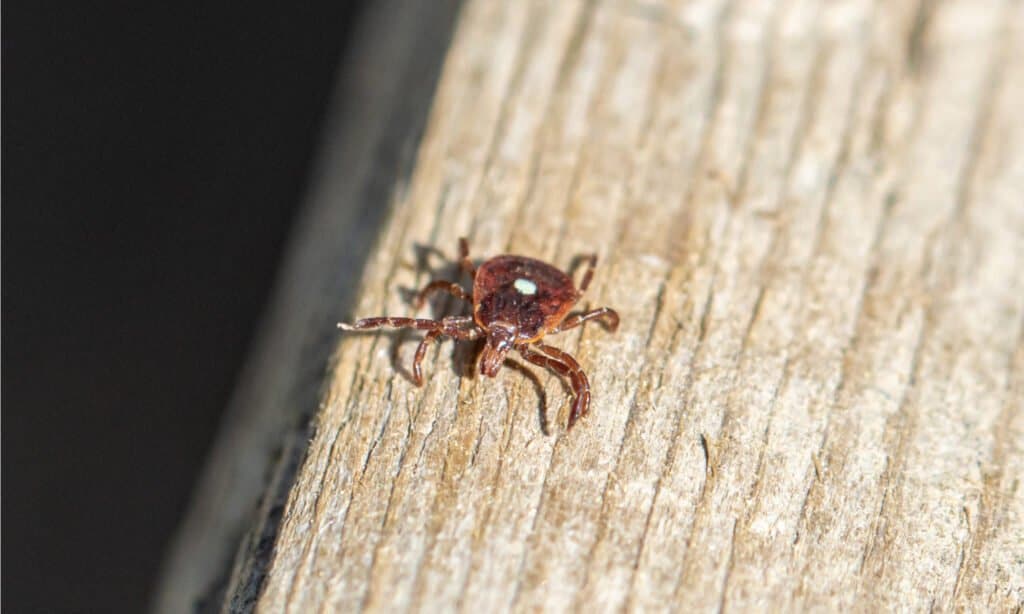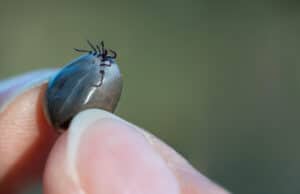Even though ticks are commonly encountered by humans, most people have no idea what they are. Do you know, for instance, that ticks aren’t actually insects? Don’t worry, you’re not the only one who didn’t realize they weren’t insects. It is a pesky little parasite that many of us do not know much about. In spite of this, it is extremely helpful to gain a deeper understanding of them. There is a lot of importance in knowing where they come from and how to recognize them. All of this information can help you avoid tick encounters in tick-infested areas by limiting your exposure to ticks.
In this article, we’ll discuss where ticks come from and more! Get ready to learn a lot about these pesky critters and better understand where these annoying pests can be found.
What Are Ticks? A Quick Rundown On These Arachnids

Ticks are arachnids which means they are more closely related to spiders.
©Maria T Hoffman/Shutterstock.com
The first thing we need to do is get the basics right. Ticks – what are they? Despite their common association with insects, ticks are not insects. Ticks belong to the arachnid family, which includes spiders, scorpions, and mites. They have four pairs of legs and no antennae, making them look almost like spiders up close. In addition, they are also parasites, which is another fascinating fact about them.
A tick feeds by attaching itself to a host and sucking blood from it. Viruses can be spread through their bites, making them harmful to organisms. A bite usually occurs in the warmest area of a host’s body. These animals are known to be present in the fur of many animals out in the wild. Wildlife animals are frequently infested with them, which can cause rashes and diseases. In addition to Lyme disease and Rocky Mountain Spotted Fever, they also transmit numerous serious diseases.
Ticks go through four stages in their life cycle: eggs, larvae, nymphs, and adults. With the exception of eggs, all other stages of them feed on blood from a variety of animals. As a result, both humans and pets are at risk from them.
Where Do Ticks Come From? What Regions Are They Found In?

There are 900 different species of ticks found around the world.
©iStock.com/Ladislav Kubeš
The world is home to many different species of these animals. Approximately 900 species of tick exist worldwide. There are two major families of ticks, the Ixodidae, which include hard ticks, and the Argasidae, which include soft ticks. The number of soft species is 700, while the number of hard tick species is 200. Among them, Nuttalliella is the most primitive species, belonging to the family Nuttalliellidae. It is native to southern Africa.
In general, they live in warm, humid climates because they require moisture to metamorphose. The development of their larvae is inhibited by low temperatures. Even so, ticks are fairly common in the United States, particularly the black-legged deer tick. A variety of other species coexist with these tiny animals, including marsupials, reptiles, mammals, birds, and amphibians. Small ticks transmit pathogens that cause diseases such as anemia and result in significant losses in livestock every year.
It is possible for them to damage the wool and hides of pet animals. Tropical bont ticks are a common parasite of livestock and wild animals in Africa, the Caribbean, and other regions. There is a flourishing population of spinose ear tick all over the world. During the juvenile stage, the spinose feeds inside the cattle’s ears.
How To Identify A Tick
A tick is a small animal that feeds on the blood of other animals, as we have already mentioned. As small as a pinhead and as large as a grape, they can be found in all sizes. Since they are related to spiders, they also have eight legs. There are a variety of species of ticks, and the color of the little creatures varies depending on the species. In addition to reddish-brown, they can also be gray, yellowish, as well as black in color. A tick grows in size when it sucks on blood and grows bigger as a result. In the case of the largest ones, they can reach a size similar to that of a marble. Some even become greenish-blue animals after eating blood for several days.
In ticks, the cephalothorax and the abdomen are fully fused, and their bodies are ovoid or pear-shaped. There is a hard covering on the upper side of them called a scutum, which serves as a shield or shielding. Hard ticks have a beak-like structure on the forward-facing side, while soft ones have mouthparts on the inside.
How To Prevent Tick Bites

There are many steps that you can take, such as using DEET spray, to avoid tick bites.
©iStock.com/cturtletrax
As people spend a greater number of hours outdoors, there is an increase in the number of insects and pests they’ll come across. Bloodsucking parasites such as ticks are among them. It is possible to contract tick-borne diseases anywhere in the world, even in your own backyard.
Taking the following precautions can help you and your family stay safe:
- Use repellents that contain DEET, permethrin, or picaridin.
- Make sure you wear clothes that cover your body parts as much as possible.
- Ensure that pants legs are tucked into socks.
- Make sure to avoid infested areas as much as possible.
- You should check yourself, your children, and your pets for bites every day, and you should remove any that you find carefully.
Although light-colored clothing is recommended to avoid these pesky bloodsuckers, studies have shown the contrary to be true. In 2005, Swedish researchers questioned the efficacy of wearing light-colored clothing for preventing tick bites. Among the ticks found on clothing, 62% were on lightweight clothing, while 38% were on heavy clothing. Researchers concluded that light clothing may attract more I. ricinus nymphs than dark clothing.
Ticks should be removed as soon as possible. Bloodstream infections, such as Lyme disease, take time to reach a person’s system. All of these precautions will help you avoid bites to the greatest extent possible, though none are 100% foolproof.
The photo featured at the top of this post is © Elliotte Rusty Harold/Shutterstock.com
Thank you for reading! Have some feedback for us? Contact the AZ Animals editorial team.






